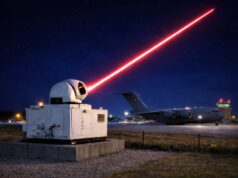The F-35 fleet recently exceeded 100,000 flight hours.
This occurred while the F-35 Integrated Test Force teams are completing the remaining requirements in the jets System Development and Demonstration phase.
Lockheed Martin Executive Vice President and F-35 Program General Manager Jeff Babione said:
“This 100K milestone marks a significant level of maturity for the program and the F-35 weapons system.
We are well positioned to complete air vehicle full 3F and mission systems software development by the end of 2017.”
The remaining development flight testing includes validating the final release of 3F software, F35B ski jump testing, F-35B austere site operations, high-Mach Loads testing for both the F-35B and F-35C and completion of the remaining weapons delivery accuracy tests.
Major SDD fleet test milestones in recent months include:
- Completed testing for the F-35A’s final envelope involving high risk ‘edge of the envelope’ maneuvers, stressing the aircraft to its limits in structural strength, vehicle systems performance, and aerodynamics while proving excellent handling qualities.
- Completed all U.K. Weapon Delivery Accuracy tests for the AIM-132 ASRAAM and Paveway IV weapons, and completed 45 of 50 SDD Weapon Delivery Accuracy tests including multiple target and multiple shot engagements as well as internal gun and centerline external pod 25mm gun accuracy tests.
- Performed multi-ship mission effectiveness tests, such as Offensive Counter-Air and Maritime Interdiction, demonstrating the performance of the F-35 System.
Three distinct variants of the F-35 Lightning II will replace the F-16 Fighting Falcon and A/OA-10 Thunderbolt II for the U.S. Air Force, the F/A-18 Hornet for the US Navy, the F/A-18 and AV8B Harrier for the US Marine Corps, and a variety of fighters for 11 other countries, to date.
Following the US Marine Corps’ July 2015 combat-ready Initial Operational Capability declaration, the US Air Force attained service IOC in Aug. 2016 and the US Navy will IOC in 2019.














Why do all photo’s of the F-35 have missiles slung under their wings? I thought the point of this plane was having the weapons internally to maintain a stealth profile?
Once you have destroyed the enemies air defence network in say the first 48 hours of a campaign, then the need for stealth capability is much reduced.
The F35 then becomes a bomb truck, delivering as much munitions as possible on enemy targets devoid of a viable air defence capability.
Maybe because a lot of times when another plane is up in the air with a good camera to take photos is during weapons integration tests and those tests are usually (always?) done with external releases first since that is the simpler case than internal weapon bay integration which requires more dramatic ejection of the missile from the bay before lighting firing its engine?
(The above is a lay-person’s guess, I have no inside knowledge in this area hence the question mark at the end of the paragraph.)
Name a fighter aircraft in use today that can’t carry weapons under its wings?
Thanks Mike & Julian – I am not military, just very interested.